Michelangelo Merisi da Caravaggio was a late sixteenth-century to early seventeenth-century Baroque Italian artist born in Milan on September 29, 1571. Caravaggio was most renowned for his hyper-realistic art style and ability to bend light around his subjects to create an eerie representation of the human form bathed in gold and darkness. Though he may be considered a master of light, Caravaggio preferred to live in the darkness, having an exceedingly violent reputation that was as prominent as his works of art. He was known to use prostitutes as models for his paintings, walk the streets of Rome with an unlicensed sword, and, most notably, take another man’s life on May 26, 1606.
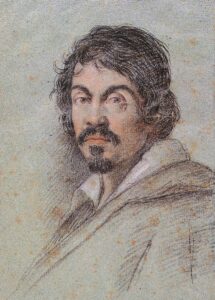
It was a Monday when Caravaggio got into a physical altercation with Ranuccio Tomassoni. The two men brawled on the tennis court near the Palazzo di Firenze, the ambassadorial residence of the Grand Duke of Tuscany. To this day, the exact cause of their fight is unknown, but theories range from a contested game of tennis to a matter involving Tomassoni’s wife. Even the type of blade Caravaggio used remains unknown, whether it was a dagger, a knife, or a sword.1 Aside from Tomassoni, three other men, including Caravaggio, were wounded, and he almost met his own fate that night at the sword of Ranuccio’s brother.
Following the murder of Tomassoni, Caravaggio received a capital sentencing, meaning that anyone could either arrest or kill him on sight. While still in Rome, Caravaggio was forced to lie low, staying at the Palazzo Giustiniani and taking shelter on the feudal estates of the Colonna family, who served as a somewhat noble protector of the infamous artist, while he made his way out of the Papal States. This escape from Rome marked the beginning of Caravaggio’s quest to receive a pardon from Pope Paul V, a quest that lasted the remainder of his life.2
The first place Caravaggio’s ventures took him to was the bustling city of Naples, the most active and populated city in Southern Europe and a city mayored by a Colonna. The trip was most likely aided by Costanza Colonna, a longtime friend of Caravaggio and daughter of Marcantonio Colonna. Her son, Fabio Colonna, was set to serve time in a prison in Milan but instead was able to get service for the Grand Master in Malta, Alof de Wignacourt. The ship set sail in July 1606, carrying both Fabio and Caravaggio, as he was set to paint a portrait of the Grand Master of the Knights of St. John.3 The city was headed by art enthusiasts and art patrons who constantly commissioned pieces for buildings, churches, and personal ownership.
Caravaggio arrived in the city in late September or early October, as proven by a commission given to him on October 6, 1606, by Nicolo Radolovic for 200 ducats. Only three months after this, he received another private commission from the Governors of Pio Monte, for which he paid double the amount he was paid by Radolovic. That commission was for one of Caravaggio’s greatest pieces, “The Seven Works of Mercy.” Documentation from Tomase di France even shows that he paid 250 ducats for a single painting from Caravaggio.4
Criminal proceedings discovered in the archives of the Holy Office of the Inquisition suggest that Caravaggio’s earliest sighting in Malta was on July 13, 1607. This dates his arrival to be approximately a full year before he was accepted into the Knights of Malta on July 14, 1608. He was spotted at a party with fellow Italian painter Giovanni Battista by a knight, Giacomo Marchese, and he was identified only a week later, on July 22, by Paul Casser, a doctor of civil and canon law. Caravaggio was a corroborative witness but knew very little of the situation at hand, nor did Marchese, who is believed to have arrived in Malta on the same day as Caravaggio. The case was eventually dropped.5
On July 24, a petition was presented in person to the Grand-Master Alof de Wignacourt by Aurelio Giustiniani, offering a property at Venosa in the Kingdom of Naples for the founding of a command by the Italian division of the Order. It can only be theorized that Caravaggio went into the company of Giustiniani, as records were not kept, most likely on account of the royal family not wanting to be connected to a murder. The Giustiniani in the petition claimed cousinship with the Cardinal Giustiniani. A true fact, but they were more distant than they had led Wignacourt to believe. On August 9, Wignacourt formally accepted the offer of Giustiniani.6
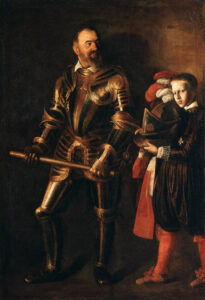
Wignacourt immediately took an interest in Caravaggio. He was so interested that he made it his mission to elevate, or “not to lose,” the Italian artist, but this turned out to be a far more difficult task than he initially anticipated. Not only did the fact that Caravaggio was a wanted murderer throw a wrench in things, but also the fact that he was not of noble blood. The Noble Knighthood was reserved specifically for the sons of the major families of the European Catholic nobility. Anyone wishing to be a knight was first required to have their family tree subjected to much scrutiny under the Statutes of the Order of St John. The Knighthood of Magistral Obedience, however, was a very low tier in the Order’s hierarchy.7 Rather than being exclusive to men of a noble bloodline, the Magistral was open to especially honorable men. Still a far cry from the rebellious artist, but made even greater by the fact that most “honorable men” were soldiers who engaged in battle for an extensive period of time, which Caravaggio obviously was not. Caravaggio was, however, the first man to claim “artistic virtuosity” as a means of getting into the knighthood. Undoubtedly, much favoritism was shown to Caravaggio. Wignacourt’s secretary, Francesco dell ‘Ante, claimed that his art could serve to glorify the Knights of Malta and their capital city.8
Had Wignacourt had it his way, Caravaggio would have been knighted in December of 1607. But this process had to be delayed due to a change made to the Order’s statutes in the Chapter General of 1604, a change that was promoted by Wignacourt, himself. The only way he knew how to overrule the statutes was through papal permission. There were two ways this could be achieved. The first was through a Chapter General, a tedious process that required months of preparation, and usually only met every four to ten years or so. The second was through a Papal dispensation delivered directly from the pope, which was another tedious process as it was the pope’s secular authority that Caravaggio had been running from.9
To aid Caravaggio, Wignacourt enlisted Roman historian Giacomo Bosio, who was a man who knew all the inner workings of Roman politics. Wignacourt advised the Order’s Ambassador, Francesco Lomellini, to follow Bosio’s advice. Bosio was the right man for the job. He managed to downplay Caravaggio’s murdering of Tomassoni by comparing the circumstance of his murder to that of his own brother, Giovanni Ottone Bosio, the right-hand man and Chancellor of Wignacourt. The murder occurred during a brawl in July of 1581 during a revolt enacted by a powerful group of knights against Grand Master Jean Levesque de la Cassière. Bosio thought he could use the precedent set by allowing his brother to be a chancellor, and the “accidental” nature of Tomassoni’s murder to allow Caravaggio a place in the knighthood. This combined with Wignacourt’s ardent support was enough for Caravaggio to be granted knighthood by Pope Paul V on February 7, 1608. His official knighting ceremony was held less than half a year later in Valletta.10
Caravaggio had been admitted into the Order as Knight of Obedience on July 14, 1608, and served as a member until August 18, just over a full month. Despite this rather famous part of Caravaggio’s story, the exact details as to why he was detained still remain unknown. Theories ranged from Malta officials finally becoming aware of the murder of Tomassoni, or the discovery of a more recent homicide committed by the deranged artist. But documents showing the existence of an inquiry ordered by the Grand Master and the Venerable Council on August 19, 1608 shows that the product of Caravaggio’s imprisonment was actually the result of a brawl he had with some of his fellow knights, Joannem Petrum de Ponte diaconum. The identity of most of the knights involved are not known, but it is stated that Giovanni Rodomonte Roero was wounded during the squirmish. The fight took place at the residence of Prospero Coppin, an organist for the Conventional Church of St. John, during which the door was smashed in.11 While the fight may have broken out at Coppin’s residence, it is unlikely that he was involved.12
The investigation was composed of Philiberto de Matha, Giovanni Gomes de Azevedo, and Antonio Turrensi. The commission submitted its first report to the Venerable Council on August 27, 1608. The members of the council were elected yearly, and had the meeting been complete, the council would have included some of Caravaggio’s greatest allies in Malta, one of which was Wignacourt. The council sought to draw up further evidence to make a case against Caravaggio and Petrum. The council heard the details of both Caravaggio’s escape from prison and his brawl in August, on November 27, 1608, and decided to follow through on his defrocking. The four other knights who were engaged in the brawl at Coppin’s were also punished. Two novices, Giovanni Pecci and Francesco Benzo, were condemned to two and four years in prison, while knight Giovanni Battista and Giulio Accarigi each received a six-month sentencing. Caravaggio and Petrum’s defrocking took place on December 1, 1608, in the Oratory of the Decollato, but by this time Caravaggio had already found another place to reside.13
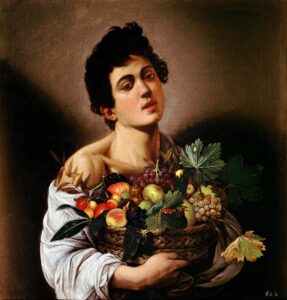
Caravaggio arrived in Syracuse, Sicily, in October 1608, where he found shelter with Mario Minniti, a man who had modeled for Caravaggio in the past, most notably in the painting “Boy with a Basket of Fruit.” During his stay, he explored some of the city’s finest equities with the company of Vincenzo Mirabella Alagona. Despite all the artistic and architectural wonders the city had to offer, Caravaggio was much more drawn to the natural beauties of the land. He had nicknamed the caverns under the Greek Theater of Syracuse “Orecchio di Dionisio” translated to “The Ear of Dionysius,” a name it is still known by to this day.
Despite having already been stripped of his knighthood, and word most likely having made it to Sicily, Caravaggio still kept the title of “Knight of St. John,” probably under the false belief that he could one day regain the title, or simply to use it when negotiating new commissions. Caravaggio did not stay in Syracuse for long. With the close relationship between the city and the Knights of Malta, Caravaggio constantly felt threatened, despite the order making no attempt to arrest him, as he was already stripped of his knighthood.
He continued to jump from city to city until eventually finding himself back in Naples in October of 1609. Immediately after his return, he was found bashed and brutalized at the Osteria del Cerriglio. After his wounds healed, he continued to paint for buyers in Naples. In the time he spent in Naples, he created some of his finest pieces, such as St. John the Baptist, and David with the Head of Goliath, for Italian Cardinal, art collector Scipione Borghese, the nephew of Pope Paul V.14

David with the head of Goliath is a painting that was made in Caravaggio’s final year. The portrait portrays the famous biblical story of David vs Goliath where a young David kills Goliath by hurling a stone at his head, then proceeding to cut the giant’s head off. His 1610 rendition of the painting was actually the third time he captured the victorious moment, having already made similar paintings in 1601-1602 and 1605.15 The first illustrates David bending over to pick up the newly severed head of Goliath. The second shows David holding the head out in front of him like a trophy, his sword held triumphantly over his shoulder, as he looks forward. But the third changes the dynamic between rivals.
The first thing anyone familiar with Caravaggio would notice is that he chose to cast himself in the role of the defeated giant: his hair messy, mouth hung open, a bloody mark on his forehead where David shot him, and blood spilling from his neck. The David in this painting is a far cry from the 1605 rendition. He holds Goliath in his left hand. His sword held even lower, leaving the frame. He stares directly at his enemy, not with honor, but with remorse and pity for the fallen soldier. The 1605 painting was done horizontally with David off-center to make room for Goliath. In his final piece, David takes center stage leaving Goliath to the dark corner on the right-hand side. The light source in the painting bounces off the flat white chest of David, highlighting only him in the abyss. The fuller of David’s sword reads “H-AS OS” an abbreviation of the Latin phrase “humilitas occidit superbiam,” which directly translates to: Humility Kills Pride.
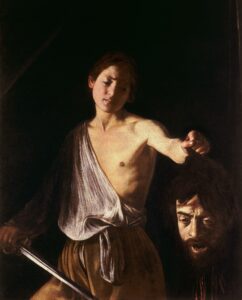
It was common for Caravaggio to add himself to his paintings. What makes “David with the Head of Goliath” so is the time in which it was painted. He painted it in his fourth year in exile and final year in life. The painting is often romanticized to be his last, or a prediction of his immediately approaching faith. In actuality, the painting could more accurately be described as a symbol of repentance.16
On his way to Rome, with the pictures promised for Borghese, he stopped at Palo del Colle, only twenty miles from Rome, where he was arrested and forced to pay a large fine. The details of what happened next are still somewhat shrouded in mystery. Caravaggio managed to make his way to Porto Ercole on the Tuscan coast, but he never left. The Baroque Italian artist passed away at the age of 38 on July 18, 1610, and the news reached Rome only ten days later on July 28, 1610.17 Multiple contradictory theories were suggested, such as that he could have been killed by a knight, or an individual paid for by the Colonna family, or that he walked for miles on a malaria-ridden beach and died of illnesses.18
Skeletal remains believed to belong to Caravaggio were dug up from the nearby cemetery of the hospital where he died. Scientists were looking for a 5’5″ male between the ages of 35 and 40 dating back to the seventeenth century, and only one fit the correct description. The examination revealed extremely high levels of lead in the bones., which would be an unsurprising fact as lead was a common ingredient in the paints Caravaggio used. Upon analysis of his teeth, the most likely cause was revealed. While lead poisoning is extremely dangerous, it is hardly ever fatal on its own. The concluding evidence of the discovered bones determined that the cause of death was Staphylococcus aureus sepsis, which occurs when staphylococcus aureus finds its way into someone’s blood.19 It is possible that lead could have worsened his sepsis, but it is just as possible that the bones analyzed could not even belong to him, and that his death remains hidden in the same shadows that he painted with and spent most of his life in.
- Arne Danielsson, “The confession of a homicide,” Journal of Art History 69, no. 3-4, (2008): 220. ↵
- Catherine Puglisi, Caravaggio: Realism, Rebellion, Reception (Delawell: University of Delaware Press, 2006), 29. ↵
- J. M. Giesen, “Caravaggio the Knight of Malta: Trading Art for a Manslaughter Charge,” International Journal of Arts & Sciences 7, no. 4 (2014): 140. ↵
- Vincenzo Pacelli, “New Documents Concerning Caravaggio in Naples,” The Burlington Magazine December, 1977, https://www.jstor.org/stable/879030 ↵
- John Spike, “‘The Church of St John in Valletta 1578-1978’ and the Earliest Record of Caravaggio in Malta: An Exhibition and Its Catalogue,” The Burlington Magazine September, 1978, https://www.jstor.org/stable/879289 ↵
- Faith Ashford, “Caravaggio’s Stay in Malta,” The Burlington Magazine for Connoisseurs, October 1935, https://www.jstor.org/stable/866309 ↵
- Keith Sciberras, “Caravaggio ‘Obbediente,’” The Burlington Magazine, June 2016, https://www.jstor.org/stable/43858800 ↵
- Keith Sciberras, “Caravaggio ‘Obbediente,’” The Burlington Magazine, June 2016, https://www.jstor.org/stable/43858800 ↵
- Keith Sciberras, “Caravaggio ‘Obbediente,’” The Burlington Magazine, June 2016, https://www.jstor.org/stable/43858800 ↵
- Keith Sciberras, “Caravaggio ‘Obbediente,’” The Burlington Magazine, June 2016, https://www.jstor.org/stable/43858800 ↵
- Keith Sciberras, “‘Frater Michael Angelus in Tumultu’: The Cause of Caravaggio’s Imprisonment in Malta,” The Burlington Magazine 144, no. 1189 (2002): 229. ↵
- Keith Sciberras, “‘Frater Michael Angelus in Tumultu’: The Cause of Caravaggio’s Imprisonment in Malta,” The Burlington Magazine, April 2002, https://www.jstor.org/stable/889491 ↵
- Keith Sciberras, “‘Frater Michael Angelus in Tumultu’: The Cause of Caravaggio’s Imprisonment in Malta,” The Burlington Magazine, April 2002, https://www.jstor.org/stable/889491 ↵
- Catherine Puglisi, Caravaggio: Realism, Rebellion, Reception (Delawell: University of Delaware Press, 2006), 31. ↵
- Veronica Polinedrio, “Caravaggio and the Head of Goliath,” Kaleidoscope 10 (2011): 5. ↵
- Catherine Puglisi, Caravaggio: Realism, Rebellion, Reception (Delawell: University of Delaware Press, 2006), 25. ↵
- Otis H. Green, and Denis Mahon, “Caravaggio’s Death: A New Document,” The Burlington Magazine, June 1951, https://www.jstor.org/stable/870609 ↵
- Catherine Puglisi, Caravaggio: Realism, Rebellion, Reception (Delawell: University of Delaware Press, 2006), 32. ↵
- Michel Drancourt, Rémi Barbieri, Elisabetta Cilli, Giorgio Gruppioni, Alda Bazaj, Giuseppe Cornaglia, and Didier Raoult, “Did Caravaggio die of Staphylococcus aureus sepsis?” The Lancet Infectious Diseases 18, no. 11 (2018): 1178. ↵
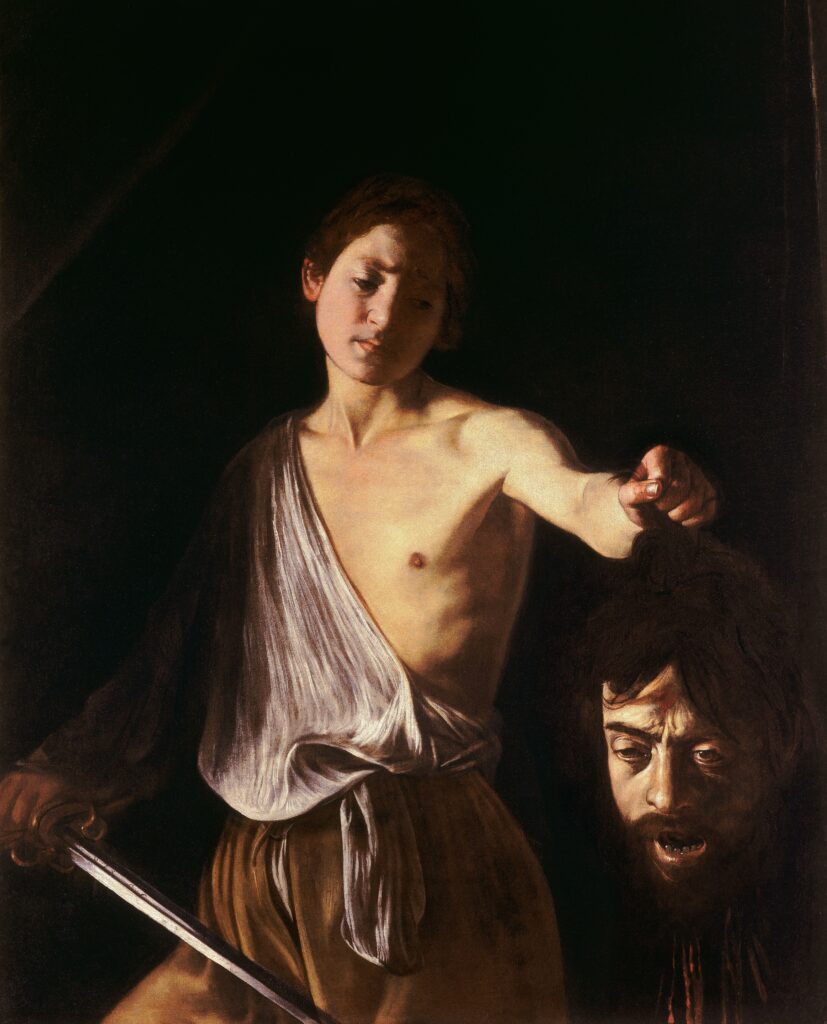
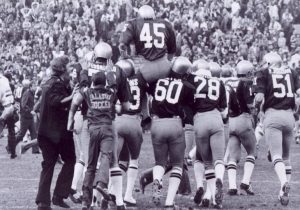
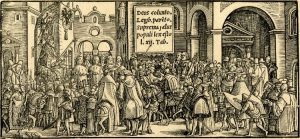
1 comment
Natalia De La Garza
Thank you for sharing such an engaging and thoroughly researched overview of Caravaggio’s fascinating life and career! Your narrative expertly balances his extraordinary talent as a master of light and realism with his tumultuous personal history.